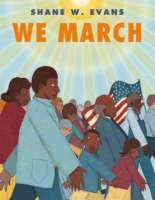
Illustrations and brief text portray the events of the 1963 march in Washington, D.C., where the Reverend Martin Luther King, Jr. delivered a historic speech.
- ISBN: 9781596435391
- Published: 2012 , Roaring Brook Press
- Themes: Black Experience, Racism
- Descriptors: Picture Book, Primary (ages 6-9), United States

Prisca:
I was really taken with We March. How Shane Evans to can use such brief text and simplified art to convey the power of that march in 1963 is amazing to me. I like that the story is written in first person and that the “we” changes across the book from referring to the boy and his family to referencing everyone who was there, even readers of the book. It was a significant event in history that this book helps make accessible to young children.
Marie:
I too really connected with this book–both as a reader and a teacher. Although the book contains sparse text, its language and pictures create a vivid and powerful story that makes a historical event compelling for today’s readers–whatever their age. Evans’ illustrations display rich characterization that connect today’s readers to a time and place very different from their own lives. I would love to partner this book with Evans’ Underground to examine how writers’ word choices are so important and how writers can create a powerful story and message even with minimal lines of text. (I also really appreciated the author’s note at the end of the text and would definitely want to share this with student readers.)
Prisca:
I agree with you about the richness of the art, Marie. Evans has a distinctive style. His use of lines really emphasizes for me the strength that was part of the march and that period of time. And feelings of hope come through in the colors. The book is a nice example of how written language and art work together in a picturebook.